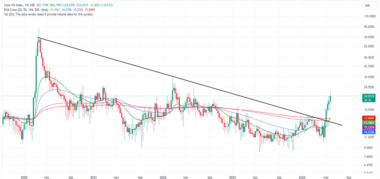By Jayesh Bhanushali, AVP, Research & Products, IIFL Capital Services
As the Lok Sabha Elections’ results date approaches, the Nifty VIX index has experienced a sharp increase after dropping approximately 20% in a single day on April 23rd. Nifty VIX is considered as a fear gauge in the stock market. It measures the implied volatility that is being priced into Nifty 50 options. Before we delve deeper into analyzing VIX, we first need to understand volatility.
There are two types of volatility: Historical and Implied. Historical volatility can be calculated using the recent trading activity in a security; it is factual and known and does not give any indication about the future price movement of the security. On the other hand, Implied volatility (IV) is a forward-looking volatility measure resulting from the market price of the options that trade on that security.
Though not a hard-and-fast rule, IV tends to increase when the underlying security is in a bearish trend. It tends to decrease when the security is bullish. This is due to the common belief that bear markets are riskier than bull markets. Although the level of IV is associated with bullish or bearish trend in the underlying, it does not predict the direction of the market. It just helps in forecasting the size of the potential swing in the underlying security.
Many traders and investors frequently wonder why there seems to be an inverse or negative relationship between stock prices and VIX. This can be explained by the nature of options purchasing. When the market is under pressure, there is a net increase in the buying of put options, leading to higher implied volatility. The surge in demand for put options drives up the implied volatility for both put and call contracts¹.
In the run-up to the Lok Sabha 2024 election results, Nifty VIX has risen to a level of more than 23. This means that the expected 30-day market movement has increased to 6.65%. If we look at the technical chart of Nifty VIX index, it has broken a downward trendline that has been in place since March 2020. This suggests a potential trend reversal. However, since the past couple of weeks, the negative correlation between the VIX and the Nifty 50 index has gone for a toss as both are rising at the same time.

We analyzed the spike on the Nifty VIX index. Since January 2011, there have been 11 instances of the VIX sharply rising, above the 15 level. In only three of these instances did the Indian market rise along with the VIX. Two of these three instances occurred during election months of 2014 and 2019. All these three instances coincided with positive global markets. Additionally, in only three out of these 11 instances did the Indian market trade contrary to global markets. A rising VIX is particularly concerning when the Indian market declines amidst a weak global market, typically resulting in an average fall of around 20%.
However, in the current market scenario, a rising VIX should not be viewed negatively as both the Indian and global markets are trading near all-time highs. We also looked at how the VIX reacted post the announcement of the past Lok Sabha Election results. The VIX saw a sharp increase in the run up to the election results. However, it saw a sharp correction as the results were announced. Below is a table depicting the movement of VIX post the announcement of the previous two Lok Sabha Election results.
| Result Date | From | To | Correction | Days taken |
| 16th May 2014 | 36.8 | 17.9 | -51% | 3 |
| 23rd May 2019 | 27.6 | 16.5 | -40% | 2 |
With the penultimate (sixth) phase of the 2024 elections over, 89% of total seats have been polled so far. The sharp decline of the voter turnout in the first 2 phases has now meaningfully narrowed down. The final turnout may end up being marginally below 2019 levels. We don’t expect 2024 elections to spring a surprise outcome like in 2004 elections. This, due to the huge vote share difference between the BJP and Congress in 2019 elections. BJP/NDA had more than 50% vote share in 224 seats in 2019 elections. We, therefore, still believe that unless there are major downswings in vote share, BJP would retain its majority. If the election results are on expected lines, a decline in the VIX from the current elevated levels is likely.
¹ – Russell Rhods, Trading VIX Derivatives: Trading and Hedging strategies using VIX Futures, Options and Exchange Traded Notes.
Related Tags

![]() IIFL Customer Care Number
IIFL Customer Care Number
(Gold/NCD/NBFC/Insurance/NPS)
1860-267-3000 / 7039-050-000
![]() IIFL Capital Services Support WhatsApp Number
IIFL Capital Services Support WhatsApp Number
+91 9892691696
IIFL Capital Services Limited - Stock Broker SEBI Regn. No: INZ000164132, PMS SEBI Regn. No: INP000002213,IA SEBI Regn. No: INA000000623, SEBI RA Regn. No: INH000000248, DP SEBI Reg. No. IN-DP-185-2016, BSE Enlistment Number (RA): 5016
ARN NO : 47791 (AMFI Registered Mutual Fund Distributor), PFRDA Reg. No. PoP 20092018

This Certificate Demonstrates That IIFL As An Organization Has Defined And Put In Place Best-Practice Information Security Processes.